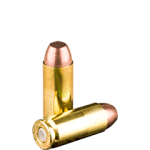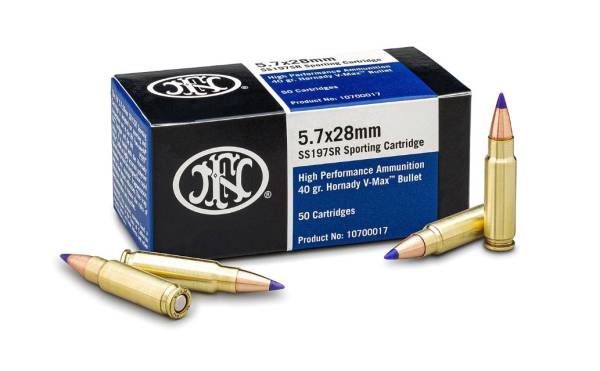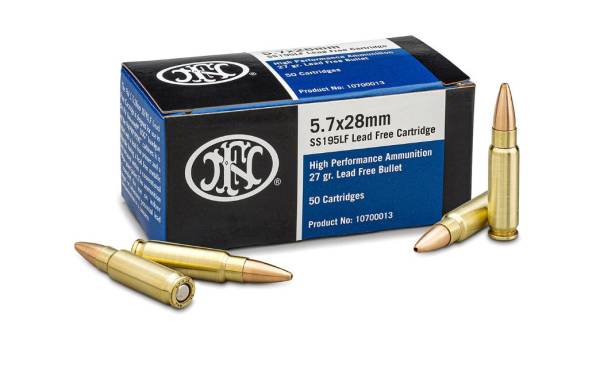Description
What does Ted Nugent have in common with FBI agents? What about Sonny Crockett from Miami Vice and the San Francisco Bay Area Rapid Transit (BART) police department? If you guessed a 10mm Auto handgun, you’re right!
Designed by Lieutenant Colonel Jeff Cooper in 1983 to replace the .45 ACP as the perfect combat pistol, the 10mm has a flatter trajectory, transfers energy better from bullet to target, and holds its accuracy at a greater range than the .45 Auto. It features a cartridge short enough to use in a semi-automatic pistol, but one that still reaches the energy and power of revolver Magnum rounds. The 10mm bullet itself weighs between 135 and 200 grain (gr) and the ammunition is commonly found in both full metal jacket (FMJ) and hollow point variations.
The 10mm bullet measures 10.17mm (.400 inch) and sits in a rimless, straight-walled casing that’s .992 inch long. Together, they measure 1.250 inches, according to the Sporting Arms and Ammunition Manufacturers’ Institute (SAAMI). The Permanent International Commission for the Proof of Small Arms (C.I.P.), the European equivalent of SAAMI, measures the ammunition standard slightly larger at 1.260 inches.
The round uses a large pistol primer and SAAMI sets the maximum pressure at 37,500 pounds per square inch (psi). C.I.P., on the other hand, lowers the max pressure to 33,000 psi.
The Development of 10mm Auto Ammo
In the late 1970s through early 1980s, Cooper, who is often considered the father of modern handgun shooting, set out to create the perfect combat pistol – one that could top the .45 ACP’s external ballistics (a heavy bullet with a slow velocity that lost power over distances), but still be shot from a service-sized semi-automatic firearm.
Along with John Adams, Whit Collins, and Irving Stone, Cooper took the shell of .30 Remington ammo (the precursor to the .30-30 rifle round), cut it down to .992 inch, and loaded it with a .40 caliber, elongated bullet. The result? The 10mm Automatic.
The word got around that the group was working on a new ammunition, and around 1980, Thomas Dornaus and Michael Dixon (of then Dornaus and Dixon Enterprises) reached out to Cooper and friends. The firearm manufacturers wanted to create a weapon that filled the gap between semi-automatic pistols and the magnum revolvers of the day. This collaboration led to the creation of the Bren Ten, the first pistol for the new 10mm ammo.
The Bren Ten was built from the standard CZ-75 and featured a five-inch barrel, high-profile sights, and a selective double action trigger. It was made of stainless steel and came with an 11-round magazine.
The task of manufacturing the ammunition was given to Norma Precision, who took Cooper’s original cartridge and increased the power. The gun and ammo were both released in 1983, with the initial ammunition featuring a 200 gr FMJ cone-shaped bullet (comparing the 9mm vs. 10mm, this shape made them very similar in look), 37,000 psi of pressure, 1,200 fps, and a muzzle energy of 635 foot pound force (ft·lb). It was a power to be reckoned with.
The 10mm’s Rocky Road
Things didn’t start out well with the 10mm, especially with the Bren Ten firearm. Soon after its release, it became evident that in a rush to get it manufactured, the Bren Ten didn’t go through rigorous enough testing, as it had multiple malfunctions. The high-pressured round battered the gun harder than it should have, causing poor accuracy and performance.
This lackluster execution not only caused people to turn away from the gun and new ammunition, but in 1986, it also resulted in the eventual bankruptcy of Dormouse and Dixon Enterprises – the unfortunate end to the Bren Ten, after only about 1,500 of the firearms had been made.
To many, this looked like the end to the 10mm round, but a few situations arose that caused things to fall into place for the ammo. First, the world’s most famous Bren Ten had been issued to Sonny Crockett, one of the lead detectives on the popular early 80s TV show, Miami Vice. While this didn’t really do anything for the gun’s popularity (Crockett’s pistol never malfunctioned), it did turn the 10mm into a household topic and, as far as ammunitions go, a cult classic.
Then the tragic 1986 Miami Shootout occured. This famous gunfight included two suspected bank robbers and eight FBI agents, who were armed with 12 gauge shotguns, 9mm semi-automatic pistols, .38 Special revolvers, and .357 Magnum revolvers. They fired about 145 shots in less than five minutes, but only 18 made contact with the suspects (six in one man, 12 in the other). Once the smoke cleared, both suspects were dead, two agents were dead, and the other six members of the shootout were injured.
The FBI pursued an investigation into the shootout that determined the situation played out the way it did because the agents’ semi-automatic weapons lacked appropriate stopping power. The revolvers, which had enough stopping power, couldn’t hold enough ammunition to be deemed effective in a shootout situation and weren’t able to be reloaded quickly enough when under pressure.
After vigorous field testing, the agency stated that it needed a bullet that could penetrate vital organs and create a large wound. They detailed their minimum requirements in a bullet, which included 12 to 18 inches of penetration in 10-percent ballistic gel, a 1.5-times expansion upon impact, all with a 100-percent weight retention. The bullet would need to effectively travel through steel, wallboard, plywood, heavy clothing, and auto glass at both 10 and 20 yards.
What’s more, it needed to fire from a service-size semi-automatic pistol that could contain a magazine that could hold more ammunition than a standard five- or six-shot wheel gun.
The performance of the 9mm and .38 Special had already been proven inadequate during the shootout. In testing, the .45 ACP couldn’t meet the ballistic standards sought by the FBI. Yet, when agents field tested the 10mm in a 1911-style firearm, it passed with flying colors – not surprisingly. Unfortunately, there were no guns available for the FBI to use with the 10mm.
The FBI sent out a request for proposal (RFP) to gun manufacturers, and both Colt and Smith & Wesson responded. Smith & Wesson won the contract when the agency opted for the Model 1076, ordering 10,000 of the full-sized stainless steel pistols with a 4.25-inch barrel. The finished product featured a bobbed hammer and no manual safety, and came standard with a nine-round single-stack magazine. Extended mags in both 11 and 15 were available.
The 10mm performed so well during the testing, the FBI also chambered a few Thompson Model 1928s, some of the early “Tommy guns,” for the caliber and put out a contract with Heckler & Koch to manufacture the MP5 submachine gun in 10mm, which would become known as the MP5/10.
While things were looking good for the 10mm at this point, field trials showed that the recoil of the big bullet was too much for the average agent. It was hard to handle and rapid fire was a struggle, even for experienced shooters.
This led to the FBI asking for the creation of a lighter load, one with less power and recoil, which would eventually become known as the 10mm Lite or the 10mm FBI. But these new bullets didn’t work well in the Smith & Wesson pistol, and modifications had to be made.
Eventually Smith & Wesson cut the excess space from the casing, shorting the overall length of the round, creating what would become known as the .40 S&W. The FBI canceled its order of the original 10mm pistols after only 2,400 were delivered, instead opting for the .40 caliber. The arrival of the .40 S&W signaled the end of the FBI’s relationship with the 10mm, but that didn’t mean things were over for the 10mm, which was proving itself quite resilient.
The 10mm Ammo Era
After the debacle with the FBI, it looked like the 10mm was going into oblivion once again, as finding the cartridges were difficult enough, let alone finding affordable bulk 10mm ammo. But in 1987, Colt released its Delta Elite, a 1911-style pistol chambered for the 10mm. Like both the Bren Ten and the Model 1076, the Delta Elite had some growing pains and modifications were necessary, but once Colt worked out the kinks, the gun became flawless.
By 1990, Glock followed suit and released the G20, a full-sized striker-style 10mm pistol. Like most Glocks, the G20 is accurate and consistent. It’s easy to shoot, easy to clean, and easy to customize. As the popularity of the 10mm grew, Glock released more models in the large caliber and currently offers the subcompact G29 and the long slide G40, both chambered in 10mm.
That same year, Smith & Wesson also released a 10mm revolver, the Model 610. This six-shot wheel gun came on a solid N-frame and used moon clips to feed the rimless ammunition into the chamber.
In 2015, SIG Sauer released its iconic P220 in the 10mm. Today, other popular firearm manufacturers offer pistols in the popular round.
Performance of the 10mm
Regardless of the FBI’s preference for the .40 S&W, the 10mm remains a capable cartridge and performs exactly as it was designed. The ammo’s velocity ranges from 1,300 to 1,600 fps, its muzzle energy exceeds 750 ft·lb, and it retains more energy at 100 yards than most .45 ACP rounds have at the muzzle.
When you look at 10mm vs 357, the 10mm Auto even tops the powerful .357 Magnum and, with full-strength ammo, almost meets the same performance standards as the .41 Magnum.
For its devoted followers, the 10mm’s heavy recoil is a small price to pay for its outstanding performance and effectiveness. It’s powerful enough for self defense and provides a semi-automatic hunting round that can take most North American game, including white tail deer. In Denmark, troops even use the round to protect themselves against polar bears.
The 10mm Automatic is still used today by the FBI Hostage Rescue Team and the agency’s Special Weapons and Tactics Team.
Ted Nugent, the American musician and gun enthusiast, swears by the 10mm. He even had a hand in creating a custom Glock G40 10mm called the NUGE/TMT Tactical. Along with much customization, the NUGE G40 features a machined American flag on the slide, Ted Nugent’s stick man logo, and his signature. The firearm comes with a matching case and only 100 were manufactured.
Types of 10mm Ammo
Like most ammunitions, the 10mm comes in a variety of forms. The two most popular styles are full metal jacket (FMJ) and jacketed hollow point (JHP).
The FMJ rounds feature a conical-shaped lead bullet encased in a harder metal, most often copper. This “jacket” allows the bullet to keep its shape as it travels toward its target, making it more effective. Although FMJ rounds are some of the cheapest 10mm ammo available, be careful using it for self defense, as it may over-penetrate.
JHP ammo also features a conical-shaped lead bullet that’s jacketed in a harder metal. They differ from FMJ bullets because the JHP bullet has an inverted hollow point at the exposed tip. This allows the projectile to expand more on impact, slowing its penetration and increasing its stopping power.
All the major American ammunition manufacturers produce the 10mm, as does SIG Sauer. Many smaller companies such as Cor-Bon, Double Tap and Triton also make semi-custom, high-performance rounds.
Common Names for 10mm Rounds
What is known today as the 10mm Automatic, the 10mm Auto was originally going to be named the .40 Super (not to be confused with the actual .40 Super that was released in 1996). Over the 35-plus years since its release, the 10mm has been called by different name variations. Some of the most common include:
10mm
10mm caliber
10mm Automatic
10mm Auto
10mm Lite
10mm FBI
Regardless of what it’s called, the 10mm and the pistols made for it have come a long way since their beginning. Although it was a rough road, it was well worth it and turned an okay caliber into one that continues to gain in popularity. And remember, a 10mm pistol makes a quality addition to any gun safe, and its presence on the range is a certain conversation starter.
FAQ
What can 10mm ammo be used for?
The 10mm is a powerful pistol round and can be used for various ends. It’s used by law enforcement and some armed forces. It’s also a popular choice for self defense and home protection. The 10mm can be used as a hunting handgun or as a backup gun when in big predator territory. It can take most of North America’s large game and is even used by troops in Denmark to protect against polar bears.
What is the best 10mm ammo for self defense?
Although all 10mm ammo is powerful enough to stop a threat, full metal jacket (FMJ) rounds may over penetrate their target, which may be problematic in some self defense situations. To reduce this risk, opt for jacketed hollow points (JHP), which expand more on impact, slowing the bullet. Specialty rounds, such as Hornady Critical Duty or Speer Gold Dot, offer precision ballistics and top performance.
What is the best 10mm ammo for hog hunting?
While most 10mm rounds are sufficient for hunting, there are a few that offer excellent performance. Federal Trophy Bonded features jacketed soft point bullets for massive wound size and Hornady XTP rounds offer great penetration for medium sized game.
Which is more powerful, the .45 ACP or the 10mm?
When comparing the .45 ACP to the 10mm, the 10mm is significantly more powerful. Although the ACP bullet has a slightly larger diameter, the 10mm has more velocity and muzzle energy, and therefore more stopping power.
What grain does 10mm ammo come in?
Most 10mm ammo ranges between 135 and 200 grain. These bullets are most often either full metal jacket (FMJ) or jacketed hollow points (JHP).
What 10mm ammo did the FBI use?
For the brief period when the FBI used the 10mm, before opting for the .40 S&W then the 9mm, they used a duty round. Currently, they use Hornady’s Critical Duty.
How available is 10mm ammo?
In today’s market, 10mm ammo is readily available. Although more expensive than popular calibers like .45 ACP and 9mm, 10mm rounds can be found in most brick and mortar gun shops and online.





